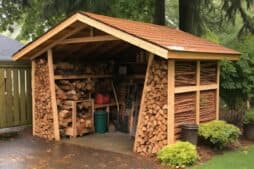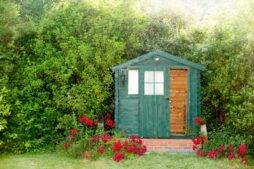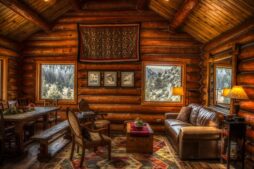Shed waterproofing is an integral part of your shed design that should never be ignored. After all, there are plenty of shed waterproofing mistakes that can be made, so it is important to avoid these where possible. In this article, you will find our recommended advice about shed waterproofing techniques, including how to waterproof a shed, waterproofing for sheds on concrete bases and shed roofs too. Here, you will learn about protecting your shed from moisture damage, choosing the right shed and building a solid base for wood preservation and roof maintenance.
Table of Contents
The Importance of Shed Waterproofing
Shed waterproofing is a crucial step in maintaining the integrity of your garden building and its contents. The reasons are clear: excess moisture can wreak havoc on your shed and its contents. Wood, especially untreated wood, is susceptible to rot when exposed to high moisture levels. Additionally, moisture buildup can lead to the growth of mould and mildew, causing unpleasant odours and potential health irritations which can affect your skin, lungs, nose, and throat.
Even your metal tools aren’t safe, as moisture can lead to rusting. Whether you plan to use your shed for tool storage, a home office, or a gym, we’re here to provide you with all the essential information to safeguard your investment.
Why To Insulate A Shed
Insulating your shed isn’t always a necessity, but it serves specific purposes. If you intend to turn your shed into an office or an extension of your home, insulation is important to maintain a comfortable year-round temperature. It is also helpful when storing equipment sensitive to extreme temperatures.
However, the decision to insulate should consider your shed’s current condition. If you have an older shed with leaks and signs of wear and tear, investing in insulation may not be cost-effective. In such cases, it’s important to address these structural issues first before moving on to insulation. Even so, you may wish to recreate your shed, and therefore, know how to build a wooden shed.
1. How To Choose The Right Shed

For this, you need to choose which shed is right for the job. If your existing shed has become distorted, has got window cavities and a leaky roof, it may be time to consider investing in a new one. While this initial expense might be excessive, it would be a wise decision to consider for a variety of purposes, including safety.
The best sheds feature shiplap construction, an upgraded version of tongue and groove cladding. If you’re starting with a tongue and groove shed, you’re already ahead in the waterproofing game. Nevertheless, to achieve ultimate protection from moisture, follow the tips outlined in this guide.
2. Building the Right Shed Base

For sheds in contact with the ground, dampness will be a constant threat. Therefore, it’s crucial to establish a proper shed base before construction. You can opt for a wooden base, which elevates the shed, allowing air circulation beneath it. To resist rot, use pressure-treated or tanalized timber.
While wooden bases work well for smaller sheds on well-drained lawns, larger sheds need sturdier foundations. Consider adding a damp-proof membrane and placing your shed on wooden base or floor bearers atop the concrete or patio to ensure proper airflow.
3. Waterproofing a shed floor
After you have structured your shed by choosing the right format and base, you can start waterproofing the shed floor. Do this by ensuring that you have a sturdy shed base and foundation in place. This will help to elevate the shed above the ground which is key to preventing water seepage from ground level and promoting air circulation beneath the shed, which keeps the floor dry.
4. Preserving the wood
Even if your shed comes with a ten-year guarantee against rot, it’s essential to treat it with wood stain annually. While the initial pressure treatment offers strong protection against fungi and insects, its effectiveness diminishes over time.
When positioning your shed, be mindful of leaving sufficient access space for easy maintenance and wood treatment application. Adequate airflow around the building is also essential, as it contributes to keeping the shed dry and free from dampness.
Opt for a high-quality water or spirit-based stain for wood treatment. Water-based stains are better since they offer quick drying and contain fewer volatile organic compounds compared to spirit-based alternatives. On the other hand, solvents provide a thinner and more spreadable fluid. However, they tend to dry more slowly and are more toxic.
5. Checking doors and windows
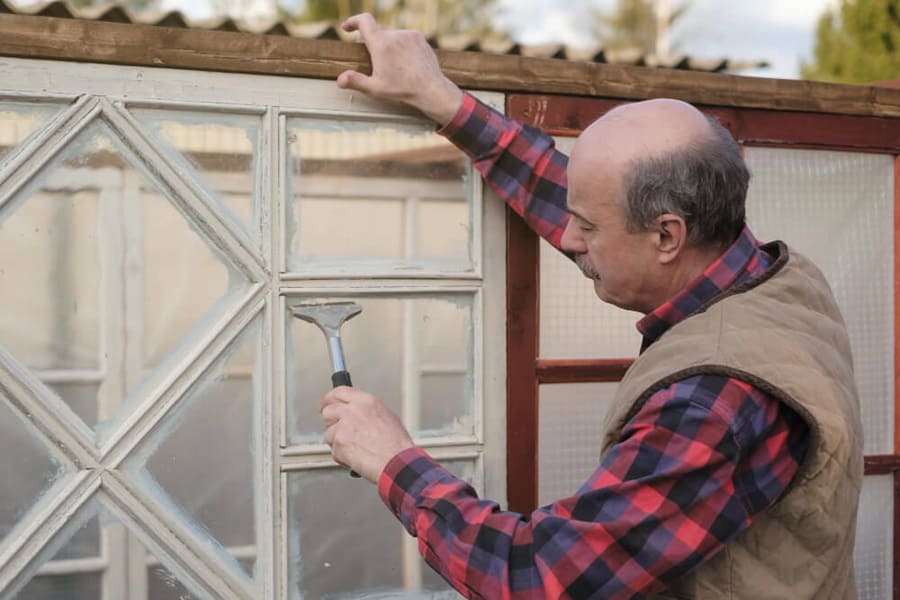
Regular attention to wooden window and door frames is crucial for maintaining their condition with your shed waterproofing techniques. Over time, wood naturally shrinks, leading to the development of cracks and gaps through which water can infiltrate. To prevent this, conduct routine checks for gaps and address them by filling them with expanding foam, builder’s caulk, or wooden splines.
Improve door seals by fitting draft excluder tape, and ideally, ensure your door features a threshold to prevent rain from blowing in underneath. If a threshold isn’t present, consider fitting a weather bar to improve the seal.
Examine your window sills, frames, and external doors for signs of rot by using a screwdriver to probe the wood. If you discover any soft patches, remove them and fill the affected areas with high-quality wood filler. Afterward, sand and repaint the surfaces to restore their integrity.
6. Cleaning the gutters and drainage features
One shed waterproofing technique that shouldn’t go untouched is managing rainwater, not only to be more eco-friendly, but to also prevent water from building up which may also lead to flooding.
Begin by inspecting your gutters for any debris or blockages. If you don’t have gutters, consider installing them to direct rainwater away from your shed. Collecting rainwater in a butt can also serve as a resource for watering your garden during dry periods. Follow this guide to learn more about how to install guttering on a shed roof.
If you’re dealing with drainage issues, which can lead to soggy ground and dampness in your shed, consider installing a French drain as an effective solution. Identify the lowest-lying side of your shed, and using a spade, dig a trench along the exterior wall, angling it away from the building.
Fill the trench with graded hardcore and chippings. This allows surface runoff to drain into the trench, preventing water buildup. Since the water is contained in rubble rather than soggy soil, it drains away faster and evaporates, reducing the risk of dampness.
If, however, you are unable to do this, consider moving your shed to a space that is less likely to gather water. For this, it is worth knowing how to dismantle a shed too.
7. Sound Roofing
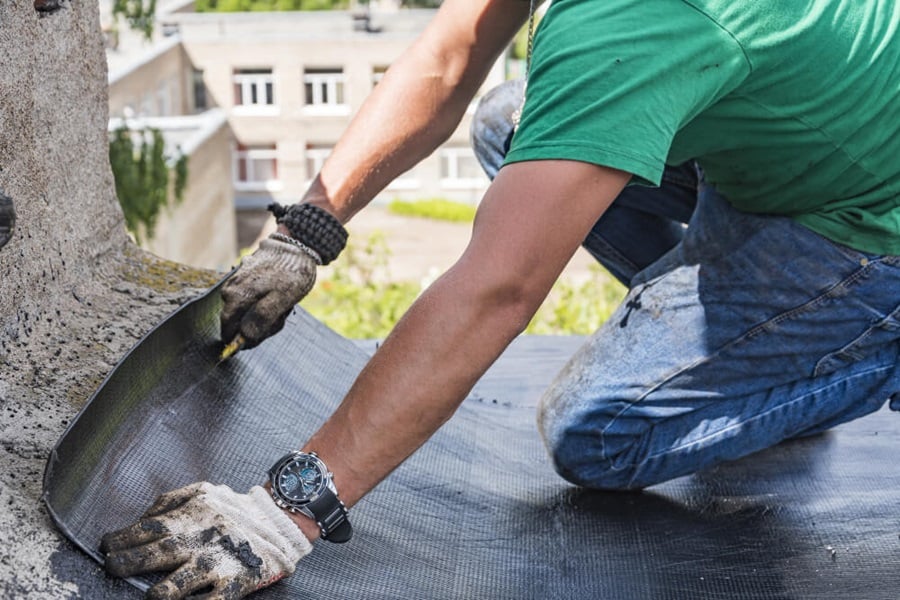
Ensuring the integrity of your shed’s waterproofing on the roof is vital. Felt is commonly added to most garden sheds which, over time, can deteriorate. Annual inspections are essential to identify damage and wear. Pay close attention to the ridge line, roof edges, and areas where the material is nailed down.
Felt damage can be easily patched. You’ll need spare felt and gutter sealant.
- Lift damaged shingles and apply sealant underneath before affixing the patch and pressing firmly.
- Spray an effective sealant below the lower part of the tear to prevent torn shingles. Press these together after spraying.
- Alternatively, replace your roofing felt. Choosing a like-for-like replacement is often the most cost-effective choice.
- You can also opt for EPDM rubber sheeting, a durable and long-lasting shed waterproofing roof solution.
8. Add Ventilation

Regardless of how watertight your shed waterproofing may be, damp days lead to damp air. Without proper ventilation, this moisture-laden air can result in a damp shed interior. Installing a pair of static vents with bug-proof mesh backing on either side of the building is pivotal for facilitating adequate airflow and preventing moisture buildup in your shed.
Additionally, consider insulating your shed. When temperatures drop below the dew point, humidity in the air can condense, potentially damaging tools and equipment. Proper insulation helps retain heat within the shed, reducing the likelihood of condensation.
How to Waterproof a Shed: The Inside
If you’re experiencing moisture inside your shed, examine the walls and roof for any gaps or holes between the cladding boards that might be allowing rain to penetrate. If such openings are found, sealing them with waterproof sealant is an effective solution. Timber sheds, in particular, may benefit from this approach, as they tend to be less airtight than metal sheds, making it easier for warm air to escape.
What Is The Most Effective Way to Waterproof a Shed Roof?
For effective shed roof waterproofing, consider laying green mineral roofing felt as soon as your shed is assembled. This cost-effective solution offers effective waterproofing while preventing mineral separation. By keeping your shed roof moisture-free for longer, you’ll extend the lifespan of both your shed and its roof.
Waterproof Your Shed Now
In summary, shed waterproofing is essential for preserving the structural integrity of your garden building and safeguarding its contents. Regular roof maintenance and adequate ventilation play vital roles in keeping your shed dry. And don’t forget to assess and seal any gaps in the shed’s cladding to prevent internal moisture. Be sure to be aware of these garden shed mistakes that could cost you £300 this winter.
FAQs
What is the cheapest way to waterproof a shed?
The cheapest way to waterproof a shed is by applying a waterproof sealant or paint to the exterior surfaces and ensuring proper drainage around the shed.
How do you waterproof an existing shed?
To waterproof an existing shed, repair any existing leaks, apply a waterproof coating or sealant to the exterior, replace damaged siding or roofing, and improve drainage to redirect water away from the shed.
How do I stop water from seeping under my shed?
You can prevent water from seeping under your shed by installing a barrier like a plastic or rubber membrane under the shed’s foundation, ensuring proper grading, and using gutters and downspouts to divert water away.
What can I use to waterproof my shed roof?
To waterproof a shed roof, you can use roofing materials like asphalt shingles, metal roofing, or rolled roofing materials, and ensure proper installation to prevent leaks. Coating with a waterproof roof sealant can also help enhance protection.
Sources
A, Ayaan., (2023) Garden shed mistake could be costing you over £300 this winter. The Mirror. [online] Available at: https://www.mirror.co.uk/news/uk-news/garden-shed-mistake-could-costing-31008961 [accessed 27/11/23]
Drainage Superstore. (n.d.) How to install guttering on a shed roof. Drainage Superstore [online] Available at: https://www.drainagesuperstore.co.uk/help-and-advice/project-guides/guttering/how-to-install-guttering-on-a-shed-roof/ [accessed 27/11/23]
Ryan Jenkins is a professional gardener and has been working in the gardening industry for over 25 years. This has allowed Ryan to accumulate a vast wealth of gardening knowledge which he shares on the Sefton Meadows blog.

